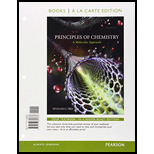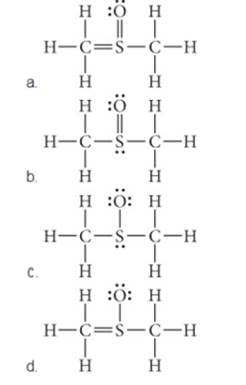
Principles of Chemistry: A Molecular Approach, Books a la Carte Plus Mastering Chemistry with eText - Access Card Package (3rd Edition)
3rd Edition
ISBN: 9780133902419
Author: Nivaldo J. Tro
Publisher: PEARSON
expand_more
expand_more
format_list_bulleted
Concept explainers
Textbook Question
Chapter 9, Problem 13SAQ
Use formal charge to choose the best Lewis structure for CH3SOCH3:

Expert Solution & Answer
Trending nowThis is a popular solution!

Students have asked these similar questions
(SE EX 2) Problems 8-11, can you please explain them to me in detail and color-code anything if necessary?
(ME EX2) Problems 15-16 Could you please explain problems 15 through 16 to me in detail, step by step? Thank you so much! If necessary, please color-code them for me.
1.)show any electrophilic aromatic substitution, identify the electriphile, nucleophile and transition state
Chapter 9 Solutions
Principles of Chemistry: A Molecular Approach, Books a la Carte Plus Mastering Chemistry with eText - Access Card Package (3rd Edition)
Ch. 9 - Prob. 9.1PCh. 9 - Arrange the compounds in order or increasing...Ch. 9 - Prob. 9.2MPCh. 9 - Prob. 9.3PCh. 9 - Prob. 9.4PCh. 9 - Prob. 9.5PCh. 9 - Prob. 9.6PCh. 9 - Prob. 9.7PCh. 9 - Prob. 9.8PCh. 9 - Prob. 9.8MP
Ch. 9 - Prob. 9.9PCh. 9 - Write the Lewis structure for XeF4.Ch. 9 - Prob. 9.10MPCh. 9 - Prob. 9.11PCh. 9 - Prob. 9.11MPCh. 9 - Prob. 1SAQCh. 9 - Prob. 2SAQCh. 9 - Prob. 3SAQCh. 9 - Prob. 4SAQCh. 9 - Prob. 5SAQCh. 9 - Prob. 6SAQCh. 9 - Prob. 7SAQCh. 9 - Prob. 8SAQCh. 9 - Prob. 9SAQCh. 9 - Prob. 10SAQCh. 9 - Prob. 11SAQCh. 9 - Prob. 12SAQCh. 9 - Use formal charge to choose the best Lewis...Ch. 9 - Use bond energies to determine Hrxnfor this...Ch. 9 - Prob. 15SAQCh. 9 - Prob. 1ECh. 9 - Prob. 2ECh. 9 - Prob. 3ECh. 9 - Prob. 4ECh. 9 - Prob. 5ECh. 9 - Prob. 6ECh. 9 - Prob. 7ECh. 9 - Prob. 8ECh. 9 - Explain the trend in the lattice energies of the...Ch. 9 - Prob. 10ECh. 9 - The lattice enerqy of CsF is -744 kJ/mol, whereas...Ch. 9 - Prob. 12ECh. 9 - Prob. 13ECh. 9 - Prob. 14ECh. 9 - Prob. 15ECh. 9 - Prob. 16ECh. 9 - Prob. 17ECh. 9 - Prob. 18ECh. 9 - Draw the Lewis structure for CO with an arrow...Ch. 9 - Prob. 20ECh. 9 - Prob. 21ECh. 9 - Prob. 22ECh. 9 - Prob. 23ECh. 9 -
24. Write the Lewis structure that obeys the...Ch. 9 - Prob. 25ECh. 9 - Use formal charge to determine which of the two...Ch. 9 - Prob. 27ECh. 9 - Prob. 28ECh. 9 - Prob. 29ECh. 9 - Prob. 30ECh. 9 - Prob. 31ECh. 9 - What are the formal charges of the atoms shown in...Ch. 9 - Write the Lewis structure for each molecule. a....Ch. 9 - Prob. 34ECh. 9 - Prob. 35ECh. 9 - Prob. 36ECh. 9 - Prob. 37ECh. 9 - Prob. 38ECh. 9 - Consider these three compounds: HCCH, H2CCH2...Ch. 9 - Prob. 40ECh. 9 - Prob. 41ECh. 9 - Prob. 42ECh. 9 - Prob. 43ECh. 9 - Prob. 44ECh. 9 - Prob. 45ECh. 9 - Prob. 46ECh. 9 - Prob. 47ECh. 9 - Amino acids are the building blocks of proteins....Ch. 9 - Prob. 49ECh. 9 - Prob. 50ECh. 9 - Prob. 51ECh. 9 - Prob. 52ECh. 9 - Prob. 53ECh. 9 - Prob. 54ECh. 9 - Prob. 55ECh. 9 - Prob. 56ECh. 9 - Prob. 57ECh. 9 - Prob. 58ECh. 9 - Prob. 59ECh. 9 - Prob. 60ECh. 9 - Prob. 61ECh. 9 - Prob. 62ECh. 9 - Prob. 63ECh. 9 - Calculate Hrxn for the combustion of octane...Ch. 9 - 65. Draw the Lewis structure for each compound.
a....Ch. 9 - Prob. 66ECh. 9 - Prob. 67ECh. 9 - Prob. 68ECh. 9 - Prob. 69ECh. 9 - Prob. 70ECh. 9 - Prob. 71ECh. 9 - Prob. 72ECh. 9 - Prob. 73ECh. 9 - Prob. 74ECh. 9 - Prob. 75ECh. 9 - Prob. 76ECh. 9 - Prob. 77ECh. 9 - Prob. 78ECh. 9 - Prob. 79ECh. 9 - Prob. 80ECh. 9 - Prob. 81ECh. 9 - Prob. 82ECh. 9 - Prob. 83E
Knowledge Booster
Learn more about
Need a deep-dive on the concept behind this application? Look no further. Learn more about this topic, chemistry and related others by exploring similar questions and additional content below.Similar questions
- (SE EX 2) Problems 15-16, can you please explain them to me in detail and color-code anything if necessary?arrow_forward(ME EX2) Can you please explain problems to me in detail, step by step? Thank you so much! If needed color code them for me.arrow_forward(SE EX 2) Problems 1-3, can you please explain them to me in detail and color code anything if needed.arrow_forward
- (SE EX 2) Problems can you please explain them to me in detail and color-code anything if necessary?arrow_forward(SE EX 2) Problems can you please explain them to me in detail and color-code anything if necessary?arrow_forward(ME EX2) Prblms 5-7 Can you please explain problems 5-7 to me in detail, step by step? Thank you so much! If needed color code them for me.arrow_forward
- Please help me understand how to predict 4-8, using the chemicals and formula equations, and ions. Is seems like a lot but that basically what I need help understanding, please! Thank you in advance. P.S - keep seeing people to reach out in the comments if I had additional questions, but I don't see one???arrow_forward(ME EX2) Problems Could you please explain problems to me in detail, step by step? Thank you so much! If necessary, please color-code them for me.arrow_forward(SE EX 2) Problems can you please explain them to me in detail and color-code anything if necessary?arrow_forward
- (SE EX 2) Problems 4-7, can you please explain them to me in detail and color-code anything if necessary?arrow_forwardCan you explain problems 20 - 25 on here (step by step) and in detail for me pleasearrow_forward(ME EX2) Can you please explain problems to me in detail, step by step? Thank you so much! If needed color code them for me.arrow_forward
arrow_back_ios
SEE MORE QUESTIONS
arrow_forward_ios
Recommended textbooks for you
 Chemistry: The Molecular ScienceChemistryISBN:9781285199047Author:John W. Moore, Conrad L. StanitskiPublisher:Cengage Learning
Chemistry: The Molecular ScienceChemistryISBN:9781285199047Author:John W. Moore, Conrad L. StanitskiPublisher:Cengage Learning Chemistry: Principles and PracticeChemistryISBN:9780534420123Author:Daniel L. Reger, Scott R. Goode, David W. Ball, Edward MercerPublisher:Cengage Learning
Chemistry: Principles and PracticeChemistryISBN:9780534420123Author:Daniel L. Reger, Scott R. Goode, David W. Ball, Edward MercerPublisher:Cengage Learning Chemistry: Principles and ReactionsChemistryISBN:9781305079373Author:William L. Masterton, Cecile N. HurleyPublisher:Cengage Learning
Chemistry: Principles and ReactionsChemistryISBN:9781305079373Author:William L. Masterton, Cecile N. HurleyPublisher:Cengage Learning Chemistry & Chemical ReactivityChemistryISBN:9781133949640Author:John C. Kotz, Paul M. Treichel, John Townsend, David TreichelPublisher:Cengage Learning
Chemistry & Chemical ReactivityChemistryISBN:9781133949640Author:John C. Kotz, Paul M. Treichel, John Townsend, David TreichelPublisher:Cengage Learning
 ChemistryChemistryISBN:9781305957404Author:Steven S. Zumdahl, Susan A. Zumdahl, Donald J. DeCostePublisher:Cengage Learning
ChemistryChemistryISBN:9781305957404Author:Steven S. Zumdahl, Susan A. Zumdahl, Donald J. DeCostePublisher:Cengage Learning

Chemistry: The Molecular Science
Chemistry
ISBN:9781285199047
Author:John W. Moore, Conrad L. Stanitski
Publisher:Cengage Learning

Chemistry: Principles and Practice
Chemistry
ISBN:9780534420123
Author:Daniel L. Reger, Scott R. Goode, David W. Ball, Edward Mercer
Publisher:Cengage Learning

Chemistry: Principles and Reactions
Chemistry
ISBN:9781305079373
Author:William L. Masterton, Cecile N. Hurley
Publisher:Cengage Learning

Chemistry & Chemical Reactivity
Chemistry
ISBN:9781133949640
Author:John C. Kotz, Paul M. Treichel, John Townsend, David Treichel
Publisher:Cengage Learning


Chemistry
Chemistry
ISBN:9781305957404
Author:Steven S. Zumdahl, Susan A. Zumdahl, Donald J. DeCoste
Publisher:Cengage Learning
Stoichiometry - Chemistry for Massive Creatures: Crash Course Chemistry #6; Author: Crash Course;https://www.youtube.com/watch?v=UL1jmJaUkaQ;License: Standard YouTube License, CC-BY
Bonding (Ionic, Covalent & Metallic) - GCSE Chemistry; Author: Science Shorts;https://www.youtube.com/watch?v=p9MA6Od-zBA;License: Standard YouTube License, CC-BY
General Chemistry 1A. Lecture 12. Two Theories of Bonding.; Author: UCI Open;https://www.youtube.com/watch?v=dLTlL9Z1bh0;License: CC-BY